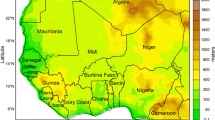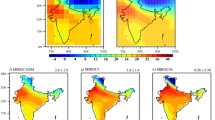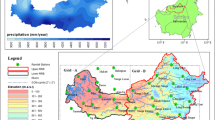Abstract
Response of Indian summer monsoon (ISM) to the historical data of 13 selected models of Coupled Model Intercomparison Project Phase 5 (CMIP5) suite has been investigated by considering the annual precipitation cycle, spatial distribution of rainfall, monsoon index, and domain along with wavelet and empirical orthogonal function (EOF) analysis. The domain of interest focuses on an area between 5°N to 45°N and 45°E to 95°E. NCEP/NCAR reanalysis, Global Precipitation Climatology Project (GPCP) and CMPA dataset are utilized for the period from 1955 to 2004. When compared with the given models, MIROC stands out to be the best suited dataset for monsoon season in Indian subcontinent. An ensemble of all the models has also been considered, and it produces good spatial and temporal distribution maps. However, it is not able to capture the peak values. MIROC has its limitations in capturing average monthly precipitation rate and rainfall distributions when compared to the reference dataset. The representation of Indian summer monsoon rainfall simulation by MIROC suggests it to be considered more consistent for the rainfall simulation projections in this highly complex climate system. This makes it more suitable and reliable for near-term to century rainfall projections in Indian subcontinent.









Similar content being viewed by others
Explore related subjects
Discover the latest articles and news from researchers in related subjects, suggested using machine learning.References
Annamalai H, Hamilton K, Sperber KR (2007) The South Asian summer monsoon and its relationship with ENSO in the IPCC AR4 simulations. J Clim 20(6):1071–1092. doi:10.1175/JCLI4035.1
Bedi HS, Bindra MMS (1980) Principal component of monsoon rainfall. Tellus 32:296–298
Biasutti M (2013) Forced Sahel rainfall trends in the CMIP5 archive. J Geophys Res Atmos. doi:10.1002/jgrd.50206
Biasutti M, Sobel AH (2009) Delayed Sahel rainfall and global seasonal cycle in a warmer climate. Geophys Res Lett 36, L23707. doi:10.1029/2009GL041303
Biasutti M, Sobel AH, Camargo SJ (2009) The role of the Sahara low in summertime Sahel rainfall variability and change in the CMIP3 models. J Clim 22(21):5755–5771. doi:10.1175%2F2009JCLI2969.1
Chen HP, Sun JQ (2013a) Projected change in East Asian summer monsoon precipitation under RCP scenario. Meteorol Atmos Phys 121:55–77
Chen H-P, Sun JQ (2013b) How large precipitation changes over global monsoon regions by CMIP5 models? Atmos Ocean Sci Lett 6(5):306–311
Christensen JH et al (2007) Regional climate projections. Climate change 2007: the physical science basis. Contribution of Working Group I to the Fourth Assessment Report of the Intergovernmental Panel on Climate Change. In: Solomon S, Qin D, Manning M, Chen Z, Marquis M, Averyt K, Tignor M, Miller H (eds) Cambridge University Press, New York, chap. 11, 235–336
Douville H, Royer J-F, Polcher J, Cox P, Gedney N, Stephenson DB, Valdes PJ (2000) Impact of CO2 doubling on the Asian summer monsoon: robust versus model-dependent responses. J Meteorol Soc Jpn 78:421–439
Du Y, Xie S-P, Yang Y-L, Zheng X-T, Liu L, Huang G (2013) Indian Ocean variability in the CMIP5 multi-model ensemble: the basin mode. J Clim 26:7240–7266
Giannini A, Biasutti M, Held I, Sobel A (2008) A global perspective on African climate. Clim Chang 90(4):359–383. doi:10.1007/s10584-008-9396-y
Hawkins E, Sutton R (2009) The potential to narrow uncertainty in regional climate predictions. Bull Am Meteorol Soc 90:1095–1107
Hsu P-C, Li T, Murakami H, Kitoh A (2013) Future change of the global monsoon revealed from 19 CMIP5 models. J Geophys Res Atmos. doi:10.1002/jgrd.50145
Huffman GJ, Bolvin DT (2011) GPCP version 2.2 combined precipitation data set documentation
Huschke RE (1959) American Meteorological Society. Glossary of meteorology, Boston, Massachusetts, 638
Janowiak JE, Xie P (1999) CAMS-OPI: a global satellite-rain gauge merged product for real-time precipitation monitoring applications. J Clim 12:3335–3342
Kim HJ, Wang B, Ding Q (2008) The global monsoon variability simulated by CMIP3 coupled climate models. J Clim 21:5271–5294. doi:10.1175/2008JCLI2041.1
Kitoh A, Endo H, Krishna Kumar K, Cavalcanti IFA, Goswami P, Zhou T (2013) Monsoons in a changing world: a regional perspective in a global context. J Geophys Res Atmos. doi:10.1002/jgrd.50258
Lee JY, Wang B (2012) Future change of global monsoon in the CMIP5. Clim Dyn. doi:10.1007/s00382-012-1564-0
Levine RC, Turner A, Marathavil D, Martin G (2013) The role of northern Arabian Sea surface temperature biases in CMIP5 model simulations and future projections of Indian summer monsoon rainfall. Clim Dyn 41(1):155–172, ISSN 1432-0894
Li C, Yannal M (1996) The onset and interannual variability of the asian summer monsoon in relation to land-sea thermal contrast. J Clim 9:358–375
Liu L, Xie S-P, Zheng X-T, Li T, Du Y, Huang G, Yu W-D (2014) Indian Ocean variability in the CMIP5 multi-model ensemble: the zonal dipole mode. Clim Dyn. doi:10.1007/s00382-013-2000-9
Matsumoto Y, Yamagata T (1991) On the origin of a model ENSO in the western Pacific. J Meteorol Soc Jpn 69:197–207
Meehl G et al (2007) Climate Change (2007): the physical science basis. Contribution of Working Group 1 to the Fourth Assessment Report of the Intergovernmental Panel on Climate Change, 747–845. Cambridge Univ. Press
Mohanty UC, Dube SK, Singh MP (1983) A study of heat and moisture budget over the Arabian Sea and their role in the onset and maintenance of summer monsoon. J Meteorol Soc Jpn 61:208–221
Ramage CS (1971) Monsoon meteorology. International Geophysics Series, vol 15. Academic Press, San Diego, p 296
Rasul G, Chaudhry QZ, Zhao SX, Zeng QC (2004) A diagnostic study of record heavy rain in twin cities Islamabad-Rawalpindi. Adv Atmos Sci 21:976–988. doi:10.1007/BF02915599
Rasul G, Chaudhry QZ, Zeng QC, Zhao SX, Gao ST (2008) Interaction of a mesoscale low and diffused tropical depression during South Asian summer monsoon. Mausam 59:453–460
Rowell D (2012) Sources of uncertainty in future changes in local precipitation. Clim Dyn 1–22. doi:10.1007/s00382-011-1210-2
Seager R et al (2007) Model projections of an imminent transition to a more arid climate in southwestern. North America. Science 316(5828):1181–1184, URL http://www.sciencemag.org/cgi/content/abstract/316/5828/1181
Seth A, Rojas M, Rauscher SA (2009) CMIP3 projected changes in the annual cycle of the South American monsoon. Clim Chang. doi:10.1007/s10584-009-9736-6
Shukla J (1987) Interannual variability of monsoons. In: Lighthill J, Pearce RP (eds) Monsoon dynamics. Cambridge University Press, Cambridge, pp 399–463
Singh CV (1999) Principal component of monsoon rainfalls in normal, flood and drought years over India. Int J Climatol 19:639–652
Sperber KR, Palmer TN (1996) Interannual tropical rainfall variability in a GCM simulation associated with the AMIP. J Clim 9(11):2727–2750
Sperber KR, Annamalai H, Kang I-S, Kitoh A, Moise A, Turner A, Wang B, Zhou T (2012) The Asian summer monsoon: an inter-comparison of CMIP5 vs. CMIP3 simulations of the late 20th century. Clim Dyn 41:2711–2744
Taylor KE, Stouffer RJ, Meehl GA (2012) An overview of CMIP5 and the experiment design. Bull Am Meteorol Soc. doi:10.1175/BAMS-D-11-00094.1
Terray P (1995) Space-time structure of monsoon interannual variability. J Clim 8:2595–2619
Torrence C, Compo GP (1998) A practical guide to wavelet analysis. Bull Am Meteorol Soc 79:61–78
Trenberth KE, Stepaniak DP, Caron JM (2000) The global monsoon as seen through the divergent atmospheric circulation. J Clim 13(22):3969–3993
Turner AG, Slingo JM (2009) Uncertainties in future projections of extreme precipitation in the Indian monsoon region. Atmos Sci Lett 10:152–158. doi:10.1002/asl.223
Vera C, Silvestri G, Liebmann B, Gonzalez P (2006) Climate change scenarios for seasonal precipitation in South America from IPCC-AR4 models. Geophys Res Lett 33. doi:10.1029/2006GL025759.
Wainer I, Webster PJ (1996) Monsoon-ENSO interaction using a simple coupled ocean–atmosphere model. J Geophys Res 101:25,599–25,614
Wang B, Ding Q (2008) Global monsoon: dominant mode of annual variation in the tropics. Dyn Atmos Oceans. doi:10.1016/j.dynatmoce.2007.05.002
Wang B, Liu J, Kim HJ, Webster P, Yim S-Y (2012) Recent change of the global monsoon precipitation (1979–2008). Clim Dyn 39(5):1123–1135. doi:10.1007/s00382-011-1266-z
Webster PJ (1987) The elementary monsoon. In: Fein JS, Stephens PL (eds) Monsoons. John Wiley and Sons, 3–32
Yang Y, Du Y, Zhang Y, Cheng X (2013) Recent changes of Northern Indian Ocean summer rainfall based on CMIP5 multi-model. J Ocean Univ China 12(2):201–208. doi:10.1007/s11802-013-2269-7
Yasunari T (1990) Impact of Indian monsoon on the coupled atmosphere/ocean system in the tropical Pacific. Meteorol Atmos Phys 44:29–41
Yin MT (1949) A synoptic-aerologic study of the onset of the summer monsoon over India and Burma. J Meteorol 6:393–400
Zheng X-T, Xie S-P, Du Y, Liu L, Huang G, Liu Q (2013) Indian Ocean dipole response to global warming in the CMIP5 multi-model ensemble. J Clim 26:6067–6080. doi:10.1175/JCLI-D-12-00638.1
Zhi X-F (2001) Interannual variability of the Indian summer monsoon and its modeling with zonally symmetric 2D-Model. Shaker Verlag, 151 pp
Acknowledgments
This study acknowledges the support of the National Basic Research Program “973” of China (2012CB955200) and Priority Academic Program Development of Jiangsu Higher Education Institutions (PAPD). We thank the World Climate Research Programme’s Working Group on Coupled Modeling, U.S. Department of Energy’s Program for Climate Model Diagnosis and Intercomparison, and Global Organization for Earth System Science Portals. We thank the climate modeling groups (listed in Table 1 of this paper) for producing and making available their model output. We are grateful to three anonymous reviewers for their comments and suggestions which helped to improve the paper.
Author information
Authors and Affiliations
Corresponding author
Rights and permissions
About this article
Cite this article
Babar, Z.A., Zhi, Xf. & Fei, G. Precipitation assessment of Indian summer monsoon based on CMIP5 climate simulations. Arab J Geosci 8, 4379–4392 (2015). https://doi.org/10.1007/s12517-014-1518-4
Received:
Accepted:
Published:
Issue Date:
DOI: https://doi.org/10.1007/s12517-014-1518-4




